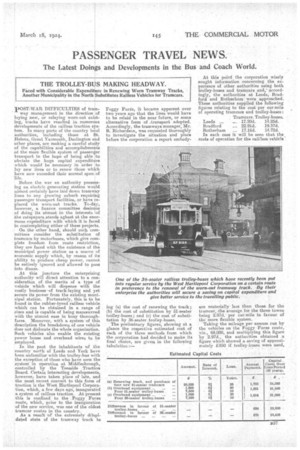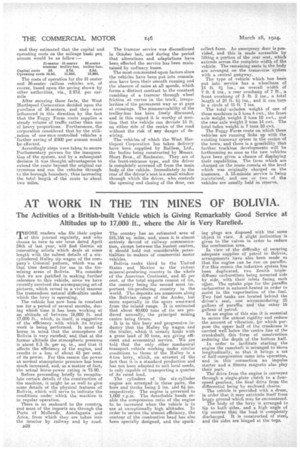PASSENGER TRAVEL NEWS.
Page 21

Page 22

If you've noticed an error in this article please click here to report it so we can fix it.
The Latest Doings and Developments in the Bus and Coach World.
THE TROLLEY-BUS MAKING HEADWAY. :
Faced with Considerable Expenditure in Renewing Worn Tramway Tracks, Another Municipality in the North Substitutes Railless Vehicles for Tramcars.
POST-WAR DIFFICULTIES of tram" way management in the direction of laying new, or relaying worn-out existing, tracks have resulted in numerchis developments of the tailless traction system. In many pants of the country local authorities, including those at St.
lens, Great Yarmouth, Darlington and other places, are making a careful study of the capabilities and accomplishments 91 the more flexible system of passenger transport in the hope of being able to obviate the huge capital expenditure which would be necessary in order to lay new lines or to renew those which have now exceeded their normal span of Before the war an authority possessing an electric generating station would almost certainly have laid down tramway lines to any growing suburb requiring passenger transport facilities, or have replaced the worn-out tracks. To-day, however, a finance committee desirous
• of doing its utmost in the interests [of the ratepayers.stands aghast at the enormous expenditure with which it is faced in contemplating either of these projects.
On .the other hand, should such committees consider the substitution of tramcars by motorbuses, which give corn. plate freedom from route restriction, they are faced with the existence of the municipal power station as a source of economic supply which, by reason of its ability to produce cheap power, cannot be entirely ignored and allowed to pass into disuse.
At this juncture the enterprising authority wilt direct attention to a consideration of the merits of a type of vehicle which will dispense with the costly business -of track-laying and yet secure its power from the existingn municipal station. Fortunately, this is td be found in the rubber-tyred railless vehicle. which can he obtained in a range of sizes and is capable of being manoeuvred with the utmost ease in busy thorough' fares. Moreover, with a system of this description the breakdown of one vehicle does not dislocate the whole organization. Such vehicles also enable the existing power heuse and overhead wires to be employed.
In the past the inhabitants iof the country north of Leeds and York have been unfamiliar with the trolley-bus with the exception of those who have seen the systeni in operation at Middlesbrough, controlled by -the Teesside Traction Board. Certain interesting developments, however; have taken place of late, and the most recent convert to this form of traction is the West Hartlepool Corpora
tion, which, a few days ago, inaugurated a system of tailless traction. At present
this is confined to the .Foggy Furze route, which, prior to the inauguration of the new service, was one of the oldest tramcar routes in the country. . As a reFsult of the extremely dilapidated state of the tramway track to
Foggy Furze, it became apparent over two years ago that the lines would have to be relaid in the near future, or some alternative form of .transport adopted. Accordingly, the tramways manager, Mr. B. Richardson, was requested thoroughly to investigate the situation and place before the corporation a report embody ing (a) the cost of renewing the track; (b) the cost of substitution by 51-seater trolley-buses; and (e) the cost of substitution by 36-seater trolley-buses. .
The preliminary figures, showing at a glance the respective estimated cost of each of the three methods from which the corporation had decided to make its final choice, are given in the following tabulation ;--
At this point the corporation wisely sought information -concerning the experience of other authorities using both trolley-buses and• tramcars and,' accordingly, the authorities at Leeds, Bradford and Rotherham were approached. These authorities supplied the following figures relating to the cost per car-mile of operating tramcars and trolley-buses:
Tramcars. Trolley-buses.
Leeds_. .., 17.20d. 14.25d.
Bradford ... 22.91d. 19.57d.
Rotherham ... 17.16d. 14.72d.
In each case it will be seen that. the costs of operation for the railliess vehicle "
are materially less than those for the tramcar, the average for the three towns being 2.97d: per car-mile in favour of
the more flexible system.
• -Takingthe mileage per annum run by the vehicles on the Foggy -Furze route, viz., 69,000, and multiptying this figure by 2.97d.; the authorities obtained . a figure which showed a saving of approxinudely £850 if, trolley-buses were used,
and they estimated that the capital and operating costs on the mileage basis pea annum would be as follow:—
al-seater 61-seater 86-seater
tramcar trolley-bee. trollepbtis.
Capital costs 6d. 3.7d.
Operating costs 18.3d. 16.88d. 15.885.
The costs of operation for the 51-seater and 36-seater railless vehicles are, of course, based upon the saving shown by other authorities, viz., 2.97d, per carmile After seauring these facts, the West Hartlepool Corporation decided upon the r nrchase of 36-seaters, and they were influenced in this direction by the fact that the Foggy Furze_ route supplies a steady volume of traffic, rather than One of heavy proportions. Furthermore, the corporation considered that by the utili zation of one-man-controlled vehicles a 'further saving of £500 per annum would be effected.
-Accordingly atens were taken to secure Parliamentary powers for the inaugura
tion of the system, and by a subsequent decision it was thought advantageous to extend the route beyond the original car terminus and run the vehicles through t3 the borough boundary, thus increasing the total length of the route to about two miles. The tramcar service was discontinued in October last, and during the period that alterations and adaptations have been effected the service has been maintained by ordinary buses.
The most-commented-upon factors since the vehicles have been put into commission have been their smooth running and the absence of noise at all speeds, which forms a distinct contrast to the constant rumbling of a tramcar through wheel friction at curves in the track, irregularities of the permanent way or at gaps at crossings. The manceuvrability of the trolley-bus has been freely dtacussed, and in this regard it is worthy of mention that the vehicle can deviate 15 ft. on either side of the centre of the road without the risk of any danger of dewiring. The vehicles of which the West Hartlepool Corporation has taken delivery have been supplied by Railless, Ltd., the bodies being constructed by Messrs. Short Bros. of Rochester. They are of the front-entrance type, and the driver is completely screened off from the main body of the vehicle. Immediately to the rear of the driver's seat is a small window through which the driver, who controls the opening and closing of the door, can collect fares. An emergency door is provided, , and this is made accessible by lifting a_ portion of the rear seat, which extends across the complete width of the vehicle. The remaining seats in the body are arranged on the transverse system with a central gangway. The type of vehicle which has been put into service has a wheelbase of 14 ft. 41 ins., an overall width of 7 ft. 6 ins., a rear overhang Of 7 ft., a front overhang of 3 ft. 2 ins., a total length of 24 ft, fat ins., and it can turn in a circle of 45 ft.. 7 ins.
The total unladen weight of one of these machines is 5 tons 4 cwt., the front axle weight weight 2 tons 10 cwt., and .the tear axle weight 2 tons 14 cwt. The total laden weight is 7 tons 10 cwt.
The Foggy Furze route on which these vehicles are running links UP with the existing tramway sytem in the centre of the town, and there is a jaossibility that further, trackless developments will he forthcoming so soon as the new vehicles have been gieen a chance of displaying their capabilities. The fares which are charged on the route remain at the level which was originally charged on the tramcars, A 15-minute service is being maintained, and one or two of the vehicles are usually held in reserve.




























